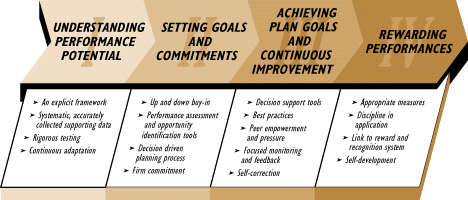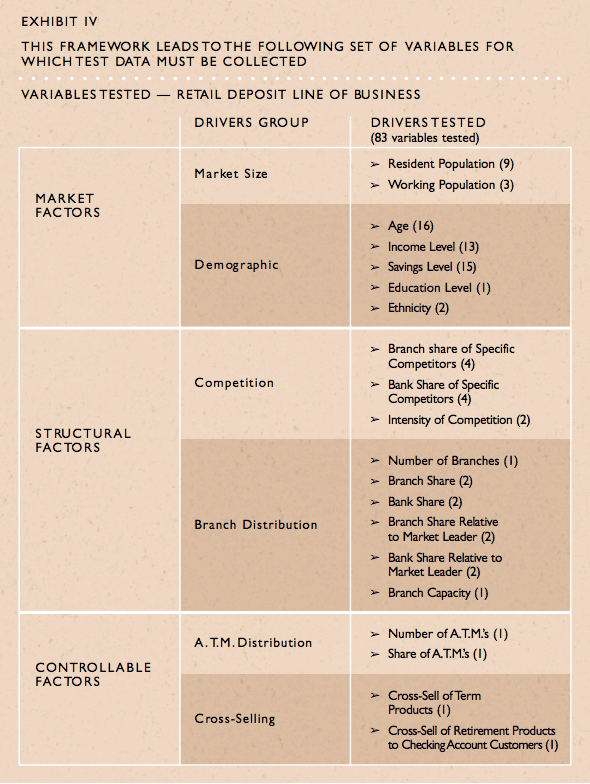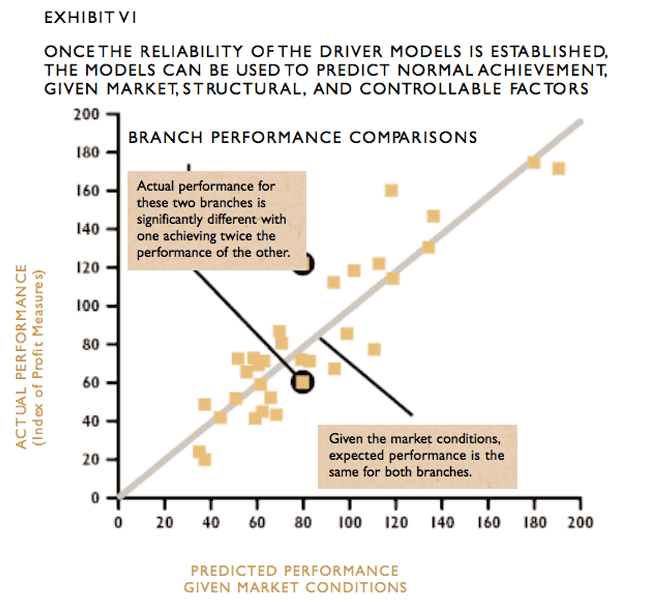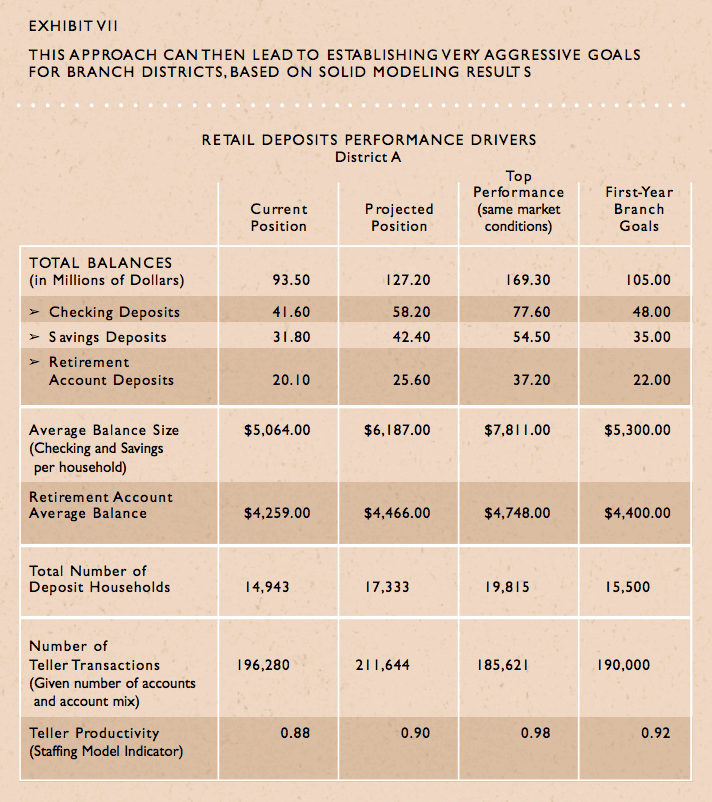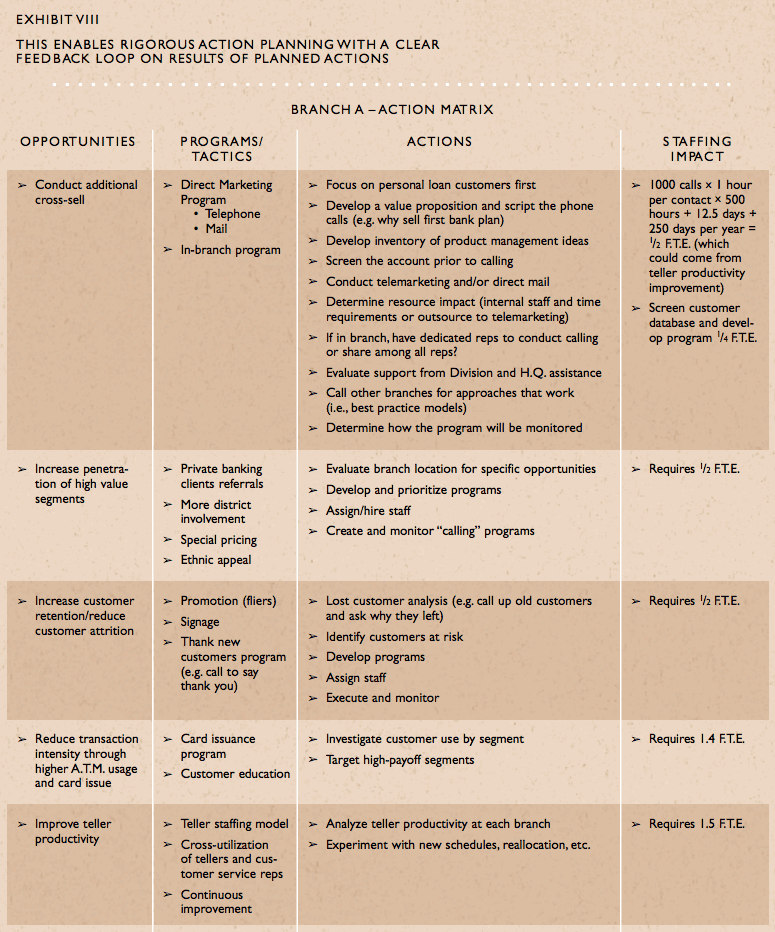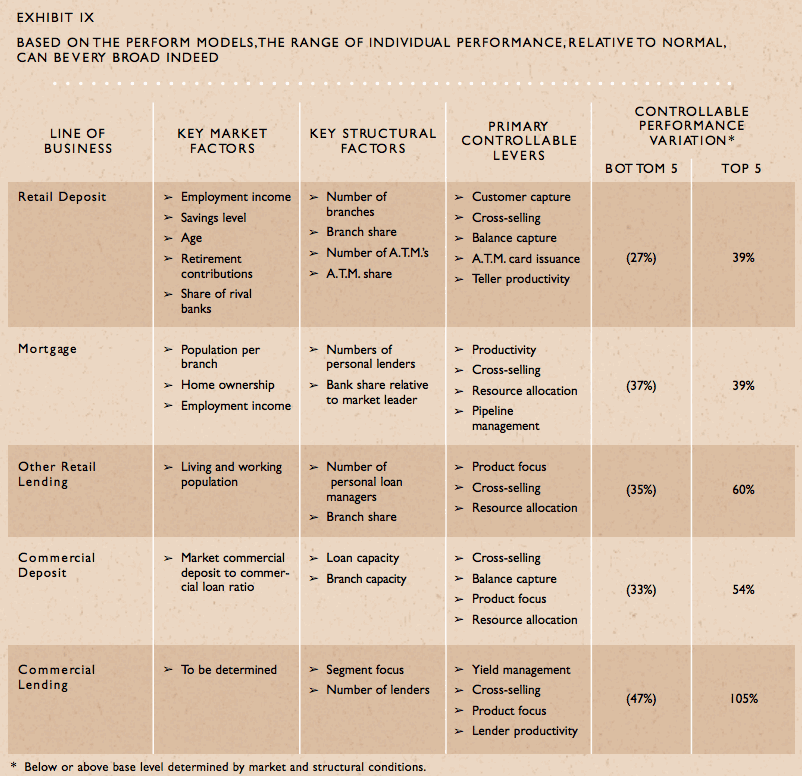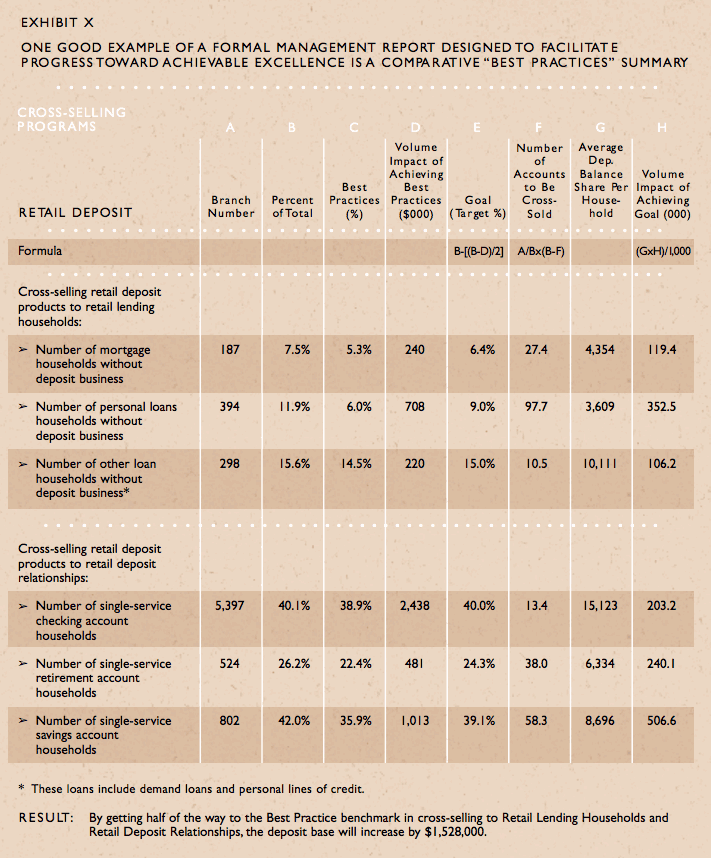The Perform System: Turning Strategies into Results
Most companies achieve less than their full potential in the market. By managing the real drivers of performance they will gain better results and their decision-making will improve.
This article was written with the Performance Management Team.
"Even the best strategies do not implement themselves" is the pithy opening sentence of this article which probably deserves a place in an anthology of business quotations. The authors suggest that many management systems come up short because they focus too narrowly on measurements and results. Measurement is not management, as they put it. Instead, they argue in favor of the Booz-Allen system, Performance Management, that continuously analyzes decision-making and draws on intra-company relationships rather than delivering a bald account of good or bad results.
A model-based management system, Performance Management incorporates a number of effective tools and processes that focus on linking operating decisions to financial performance. The model is upgraded as the business evolves - and its information communicated to all levels of management. Among its attributes are the capturing of knowledge across a company's business units which enables managers to emulate the successes of the best performers. In essence, therefore, Performance Management goes directly to the heart of a company's behavior.
The starting point for Performance Management is the creation of a new set of measures to connect business goals to each line manager's accountability. This permits managers to measure actual performance against the true potential of the business, helping them choose between short-run and long-run financial returns when making critical operating decisions.
Comparing Performance Management with the Balanced Scorecard -a well-known performance and accounting system - the authors say that, while a scorecard can be important in assessing management performance, it is not a decision-tool for enhancing performance. With Performance Management, decisions are linked to performance targets, which in turn must be linked to action plans designed to produce the intended results.
Even the best strategies do not implement themselves. One reason is that most management systems--planning, budgeting and internal reporting--are simply not very effective. These systems often fall short because they focus narrowly on financial measures and results, rather than on the real drivers of business decisions. The concept of a broader, strategically focused measurement approach is illustrated in Exhibit I, taken from a presentation by the managing director of a major global energy services company.
| Exhibit I A Strategic View of "Measurement" |
|---|
What Do I Measure?
|
How Do I Use the Measurements to Get Results?
|
| Source: Norman Chambers, Managing Director Brown & Root Energy Services, Europe and Africa |
But measurement--while critically important--is not management; it is merely an element in a modern performance-focused management system. Effective management systems must meet four broad design tests:
- They must set fair "stretch" targets. The effectiveness of a management system depends upon its ability to set stretch targets that drive performance to the maximum potential. The credibility of the system rests on its ability to set targets that are achievable and fair.
- They must manage the "drivers," not the results. Traditionally, commitments have been expressed in dollar terms. With this type of accountability, it is inevitable that management will attempt to influence financial results directly. This can produce highly dysfunctional outcomes. As a result, it is vital to shift the emphasis of commitments from narrow financial goals to operational drivers. With targets expressed as operational measures, a meaningful operational analysis can follow. Without this shift, performance measurement is a marginal activity.
- They must be able to focus their analysis on an understanding of root causes.
- They must reward good decision-making, not just good results. High-performance management systems have another function. They must facilitate what we call multidimensional connectedness within companies. By connectedness we mean these systems must create links between:
- Strategy and ongoing management decisions and actions.
- The full potential of the business and the satisfying of goals that result from the conventional planning/budgeting process.
- Management commitments and the management decisions that deliver them.
- Top management and the line-responsible management team.
- The functional and the operating units that form the line-responsible management team.
- The line-responsible management team and the finance and control community.
- The managing operational capabilities, as the cause, and financial performance, as the result.
- The time when new insights about the future are systematically acquired and the time decisions to adjust are made.
|
The Performance Management System, a model-based management system, incorporates a number of effective tools and processes that deliver into line managers' hands the capabilities to identify and achieve the full near-to-intermediate-term potential of the business; it is also designed to enable companies to achieve greater levels of connectedness. The key to doing this is to create a business model that explicitly links operating decisions to financial performance. As a result, the system gives senior management the understanding and leverage to create a true performance-focused organization. In addition, it upgrades the model as the business evolves and it communicates and explains the model to all levels of management. The Performance Management System permits managers to measure actual performance against the true potential of the business, helping managers directly assess tradeoffs between short-run and long-run financial returns when making critical operating decisions. It captures learning across business units and enables managers to emulate the successes of the best performers. And it provides a balanced mix between peer pressure and "stretch" performance incentives to facilitate managers behaving like owners. The starting point for a Performance Management system is the creation of a new set of measures to connect business goals to each line manager's accountability. The process involves four steps:
Exhibit II presents a schematic overview of these four critical elements of The Performance Management System. This article illustrates the concepts behind a Performance Management system currently in operation at a major bank holding company. EXHIBIT II THE FOUR CRITICAL ELEMENTS OF A PERFORMANCE-FOCUSED MANAGEMENT SYTEM The first element in the perform system is to gain an understanding of the company's performance potential. Management typically has an intuitive or implicit understanding of what drives actual and potential performance. In some cases, management has been able to quantify its understanding quite precisely. For example, most airline executives know exactly how much aircraft utilization and passenger load factors influence financial performance. But in many other cases, this understanding is either unquantified (though perhaps directionally correct) or based on an outdated history or on misleading anecdotal evidence. In particular, camouflaged or counterintuitive effects often escape notice or precise assessment. For example, in banking, the hidden impact of loan pricing decisions on credit quality and operating expenses can undermine loan profitability models based on net interest margins.
Management must harness the model-based insights into true performance potential to identify performance-driving business decisions and to set goals and commitments. Four ingredients are required for this second element:
The third element in the Performance Management System is the formal systems to facilitate achieving plan goals and continuous improvement. The necessary ingredients include:
The fourth element of the Performance Management System is rewarding performance. Even when companies already have sophisticated reward systems in place, Performance Management can help good systems get better on four dimensions:
The Benefits of Performance-Focused Management. Companies can expect to realize four specific benefits from performance-focused management systems: 1) almost immediately, higher earnings and cash flow based on a better understanding of the most important operating levers; 2) higher financial targets for subsequent years; 3) more effective utilization of the organization's physical and human resources, and 4) more rapid response to changing market conditions and operating performance. However, as is perhaps to be expected from a process that alters the fabric of organizational interaction, the benefits companies perceive most sharply are qualitative, reflected in greater "connectedness" across all the dimensions outlined earlier. Another way to think about the benefits is in time-phased stages from near to longer term:
Is The Performance Management System devoid of a strategic dimension? Yes, in the sense that it does not deal directly with strategy formulation. Better strategy is not a direct output. The management system does assume that current strategy is a given. But The Performance Management System does interact with the strategy formulation process in three important ways. First, it will help to point out clearly the performance limitations imbedded in current strategies. Second, it will demonstrate which structural drivers in the current strategy are limiting performance potential the most. And third, it can demonstrate new ways to restructure the business to enhance performance potential. Thus, although the system is primarily for strategy implementation, it can also play an important role in the ongoing process of recalibrating existing strategies. Is the Performance Management System's impact limited by a short-term bias? The goal of the system is to maximally improve near-to-intermediate-term financial performance. In this sense, the Performance Management System demonstrates a short-term "bias." But careful attention to near- and intermediate-term financial results is not an unusual trait among effective managers. In fact, it is very common. Short-run results are not the sole concern of managers, but they are important. The Performance Management System is a powerful management tool precisely because it does emphasize financial performance and deals explicitly with the business drivers that produce financial performance. This is hardly a dysfunctional bias in any meaningful sense. A Context for Implementing Performance Management Five conditions are necessary for successful establishment of a Performance Management System management system. First, the business must have fully accepted the belief that effective strategy derives from "capabilities" much more than from product or market "positioning." The transition from positioning-based strategic planning to capabilities-based strategic management is perhaps the most basic change in strategic thinking over the past 10 years. It is appropriate that capabilities-based strategy dominates the marketplace for ideas today. Top management must believe this, too. Second, not only must there be a commitment to capabilities-based strategy, there must also be in place a well-conceived specific strategy for driving the intermediate-term transformation of the business toward sustained higher levels of performance. Third, the business must have high potential for short-term growth in net income from more effective conversion of strategic initiatives into line decisions. Potential net income must run substantially ahead of normal expected shareholder returns. Dialogue between top management and the line organization needs to result in a "connected" understanding of what is possible if the business can perform the best it can be. When top management and the line become comfortable with this understanding, "stretch" planning goes away. Stretch goals/targets from the top are replaced by an understanding from within the line of the upper limit of potential performance. Because this level of potential performance is very high relative to past expectations, top-down planning can focus on setting the lower limit according to what is required to meet shareholders' expectations for superior returns. This lower limit becomes an inviolate threshold that the line-responsible team commits to meet or exceed. Because the threshold is based on rigorous determination of competitively driven expectations for returns, the team can readily see its validity and buy into the commitment without coercion or "bargaining." Fourth, buy-in and commitment to at least threshold performance must be present all along the line organization. What secures the achievement of the track record and, therefore, becomes the basis for top management delegating the authority to execute it is active use of the system. Performance Management systems not only drive the determination of potential performance, they also greatly reduce the time gap between systematically acquiring new insight about the future and deciding how to adjust. The ability of the line-responsible team to use the system well is what allows top management the confidence to pro-actively set shareholders' expectations for superior returns while knowing they will usually be met or even exceeded. In the worst case, there will be cogent early warning of truly unavoidable shortfalls. When this happens, open dialogue, based on the Performance Management system, can quickly bring top management and the line team into agreement as to what to do and why. Fifth and finally, the company must already be committed to significant, ongoing "change" as the normal situation, now and in the future. Meaningful change is neither continuous nor incremental. It often appears that way from the outside for successful companies with well-established strategies and deeply rooted momentum. The reality is that somewhere in virtually all organizations a step improvement in capabilities performance is being implemented almost all the time. Breaking constraints is a discontinuous activity. The consequence, once the constraint is broken, is almost always a jump to a different level of performance. For such companies, net income growth is driven more by discoveries and changes that take place well down within the business than by decisions at the top about discrete investment projects. From "Command/Control" to "Change-Driving" Mode This change-driving mode is at odds with the operating-control mode of most companies' management systems. Conventional operating-control systems are based on a commitment by the business to an agreed top-down and bottom-up plan. That commitment leads top management to vest the line team with authority and responsibility to execute the plan. Measurements hold those responsible accountable. Incentives and rewards insure the commitment is attended to. Management must be prepared to acknowledge that a net income growth model based on discontinuous, non-incremental change in capabilities will conflict with these elements of conventional operating control systems. The most obvious way to resolve the conflict between the two modes of operation is to make one dominant over the other. When strategy was mostly focused on position and the objective of a business could largely be realized as the direct consequence of specific investment decisions, the conflict between top-down and bottom-up planning was not intrinsically great. Legitimate agreement and commitment could usually be achieved either naturally or through iteration of predetermined bottom-up actions and their investment consequences. This is not the world in which most businesses compete today. In the current environment, it is not competition for position itself, but for change in position that predominates. As a result, successful competitors focus their strategy on building and deploying the critical capabilities that will allow them to do this best. This environment is just not congruent with traditional, bottom-up planning that focuses on position, long-cycle future developments, capital investment and incremental change in net income. Top management must accept the reality of this new environment before performance-focused management systems can be successfully implemented. When the context is appropriate and where traditional management systems are a key "inhibitor," The Performance Management System can be a powerful "enabler" of business change precisely because it explicitly connects business goals and drivers with potential and actual performance. Performance Management in ActionPerformance Management is typically implemented when senior management loses patience with the continuing cycle of "negotiated" financial targets that have no clear link to what is really achievable in the business units nor to the operational drivers that produce the results. The first step is to develop a plausible descriptive "model" of the business unit. What are the key business drivers? How do they interrelate to produce financial results? Exhibit III illustrates this step for consumer deposits in the retail banking division of a major bank holding company. The second step is to formally identify and define all the possible variables that might drive the descriptive model. The intent here is to be as inclusive as possible. Exhibit IV illustrates this step for the descriptive model in Exhibit III. Here, 83 possible drivers (variables) were identified for further analysis. The third step is careful, formal statistical analysis of all these variables, and their interrelationships, as drivers of the level of consumer deposit profitability. The goal is to find as small a set of drivers as possible to explain as much as possible of the variation in each of the key elements of the overall model. In Exhibit V, it is shown that 76 percent of the variation in one segment of retail deposits -- retirement accounts -- is explained by the combination of only four drivers: number of branches, market share of branches, market propensity to save and age distribution. There is certainly a high degree of common sense in concluding that the size of retirement account balances is driven by variables like these. But the power of Performance Management is to show just how much of the variation is caused by such a small subset of the 83 variables and their interactions. The next step is to pull together the best results from the intermediate modeling stages to see how much of the overall variation in branch profitability can be explained by this set of specific component models, of which Exhibit IV is one example. In Exhibit VI, a summary model is illustrated. Here the tight scatter of individual branches along the prediction line makes it clear that the Performance Management models do capture most of the underlying variation in branch profitability. Now the performance of individual branches can be compared after controlling for the particular business conditions faced by each. Exhibit VI, illustrates two branches that face comparable business conditions but produce quite different financial results. The stage is set to focus the planning effort in each branch around the demonstrated potential for profit with best-practices management of controllable factors, given the business conditions faced by the branch. Exhibit VII illustrates a diagnostic scorecard for one "underperforming" branch. This exhibit illustrates the branch's position on several key variables that drive retail deposit profitability. The first column in Exhibit VII shows the actual results for the branch. The next column shows the predicted results given the business conditions for the branch. The third column shows "best practices" results for other branches, given the specific business conditions. It is now very hard for the branch manager to reject the idea that the branch is underperforming and really should, and must, do better. The final column illustrates the next step in The Performance Management System -- converting the modeling results into specific goals for the branch. Exhibit VII illustrates the one-year targets for Branch A on this set of key controllable drivers. Notice that significant progress is planned, but that the targets are still quite modest in relation to best practices. Branch A now knows what factors must be improved, knows what constitutes "achievable excellence" for each factor and knows that the targeted improvement is well within achievable limits. There is still "negotiation" involved in setting the one-year targets in the last column. But now the negotiation is firmly grounded in an explicit model of the underlying causal relationships, with no obfuscation about "how good is good enough." It is now time for converting the one-year targets into action plans. The next step is to lay out the programs/tactics/opportunities and staffing assignments directed at achieving the one- year targets. Again, comparisons with best practices across the branch network are now explicit and tangible. Exhibit VIII illustrates some of the specific action programs for Branch A that support the "stretch" targets from Exhibit VII. The first segment of Exhibit VIII deals with one of the key themes for improved profitability that the Performance Management System models have identified-- more intensive "cross selling" of services to customers who use only part of the branch's service mix. Exhibit IX illustrates the dramatic improvement in profitability that can be achieved across various segments of branch operations, given the key market and structural factors of a branch, by just focusing action programs around the small set of key controllable drivers. Once the new year has begun and the action programs are under way, the next key step in the Performance Management System is to provide regular feedback to branch management about the success or failure of the improvement efforts. Milestone reporting on the results of key action programs is necessary to keep management attention focused on the commitments. Exhibit X illustrates a milestone report for Branch A on cross-selling success. The report also shows the predicted impact on branch deposits if the planned cross-selling programs are successful. Notice that this report focuses on success in achieving the modeled drivers of profitability rather than on the financial results themselves. That makes it much more actionable and much more effective as a feedback mechanism. As we have said,understand the key drivers, manage them and the results will follow. Perform and The Balanced ScorecardThe Balanced Scorecard, a performance and accounting system developed by Robert S. Kaplan of the Harvard Business School and David P. Norton, a consultant, has become popular because it extends management reporting beyond a narrow, financial focus while avoiding the common pitfalls of an ad hoc measures approach. Despite its appeal, the Balanced Scorecard approach does not go far enough to make it fully useful as a management tool. In fact, its approach involves a serious flaw that negates much of the promised benefit: it has no mechanism for maximizing near- and intermediate-term financial performance. In other words, while it does measure variables that are important in achieving a company's strategic objectives, it does not explicitly link them to each other or to the company's financial measurement system. As a managerial tool, the Balanced Scorecard has four serious limitations. First, it is a "scorecard" and not a decision tool. While it focuses on measures across four critical aspects of business positioning (customers, shareholders, internal processes and value creation), it does not focus on how to achieve those results. Scorecards are undeniably important elements in assessing management performance. But they are not tools to enhance performance. Focusing on scorecards can lead to lack of focus on the underlying actions that produce a good score. A tennis player who watched the scoreboard intently, instead of the ball, the court and the opponent, would not win a game, much less a match, no matter how well designed the scoreboard. Second, scorecards clearly reflect a top-down focus on the business. The measures emphasized are the summaries that are most relevant at top management levels. While it is true that this focus avoids the pitfalls of the purely bottom-up perspective, purely top-down is no less a problem. The trick is to blend top-down and bottom-up perspectives, not focus solely on one or the other. Third, the Balanced Scorecard does not provide guidance on how good a score is possible for any of the measures. External benchmarking is as far as Mr. Kaplan and Mr. Norton take the question of "how good is good enough." But a scorecard is much more valuable when the scores can be related to achievable excellence. Finally, the lack of direct and explicit links between the financial and non-financial segments of the Balanced Scorecard relegates the non-financial segments to "the back of the bus" whenever they are in conflict with the financial segments. In fact, Mr. Kaplan and Mr. Norton acknowledge that "the alleged [sic] linkage between improved operating performance and financial success is actually quite tenuous and uncertain." They see this as a problem that must be accepted, rather than one that can be solved. Reprint No. 95402 |


